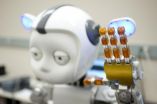(Press-News.org) Getting someone's attention can be easy with a loud noise or a shout, but what if the situation calls for a little more tact? How can a robot use subtle cues to attract a human's notice and tell when it has captured it? In a preliminary study, researchers at the Georgia Institute of Technology have found that they can program a robot to understand when it gains a human's attention and when it falls short. The research is being presented today at the Human-Robot Interaction conference in Lausanne, Switzerland.
"The primary focus was trying to give Simon, our robot, the ability to understand when a human being seems to be reacting appropriately, or in some sense is interested now in a response with respect to Simon and to be able to do it using a visual medium, a camera," said Aaron Bobick, professor and chair of the School of Interactive Computing in Georgia Tech's College of Computing.
Using the socially expressive robot Simon, from Assistant Professor Andrea Thomaz's Socially Intelligent Machines lab, researchers wanted to see if they could tell when he had successfully attracted the attention of a human who was busily engaged in a task and when he had not.
"Simon would make some form of a gesture, or some form of an action when the user was present, and the computer vision task was to try to determine whether or not you had captured the attention of the human being," said Bobick.
With close to 80 percent accuracy Simon was able to tell, using only his cameras as a guide, whether someone was paying attention to him or ignoring him.
"We would like to bring robots into the human world. That means they have to engage with human beings, and human beings have an expectation of being engaged in a way similar to the way other human beings would engage with them," said Bobick.
"Other human beings understand turn-taking. They understand that if I make some indication, they'll turn and face someone when they want to engage with them and they won't when they don't want to engage with them. In order for these robots to work with us effectively, they have to obey these same kinds of social conventions, which means they have to perceive the same thing humans perceive in determining how to abide by those conventions," he added.
Researchers plan to go further with their investigations into how Simon can read communication cues by studying whether he can tell by a person's gaze whether they are paying attention or using elements of language or other actions.
"Previously people would have pre-defined notions of what the user should do in a particular context and they would look for those," said Bobick. "That only works when the person behaves exactly as expected. Our approach, which I think is the most novel element, is to use the user's current behavior as the baseline and observe what changes."
INFORMATION:
The research team for this study consisted of Bobick, Thomaz, doctoral student Jinhan Lee and undergraduate student Jeffrey Kiser.
Video for this story is on our YouTube site at http://www.youtube.com/watch?v=F1SOoGJGT3I
How can robots get our attention?
2011-03-09
ELSE PRESS RELEASES FROM THIS DATE:
Earth: Alive -- bacteria back from the brink
2011-03-09
Alexandria, VA – In 1993, "Jurassic Park" thrilled the world with the idea that dinosaurs could be resurrected from bits of DNA preserved in mosquitoes trapped in ancient amber. In the 18 years since the movie came out, scientists have been finding that parts of this scenario are closer to reality than anyone ever imagined: Researchers have found microbes living for tens of thousands - and maybe millions - of years inside salt crystals.
These findings raise exciting questions, as EARTH explores in "Bacteria Back From the Brink" in the April issue. Could these hibernating ...
Eating disorders and body dissatisfaction is double in Muslim teenagers than in Christian
2011-03-09
This release is available in Spanish and French.
The incidence of eating disorders was found to be 2.3-fold higher among Muslim adolescents than among their Christian classmates. Similarly, body dissatisfaction was 1.8-fold higher in the former group. Finally, as a general conclusion, an average of one in four adolescents suffers some type of eating disorder, and 15% suffers body dissatisfaction. These were the conclusions drawn of a research conducted at the University of Granada.
The sample was taken from a Spanish multicultural city, Ceuta, where different religious ...
Migrating moths and songbirds travel at similar rates
2011-03-09
A study published today (09 March) in Proceedings of the Royal Society B by researchers at Rothamsted Research (an institute of the Biotechnology and Biological Sciences Research Council), and the universities of Lund (Sweden), Greenwich and York, reports the surprising finding that night-flying moths are able to match their songbird counterparts for travel speed and direction during their annual migrations but they use quite different strategies to do so - information that adds to our understanding of the lifestyle of such insects, which are important for maintaining ...
University of South Florida researchers find blood-brain barrier damaged by disease
2011-03-09
A study into the effects of Sanfilippo Syndrome type B (MPS III B) has found that the barrier responsible for protecting the brain from the entry of harmful blood-borne substances is structurally and functionally damaged by the devastating disease. University of South Florida researchers identified damage in specific brain structures involved in the pathology of MPS III B, one of four Sanfilippo syndromes, all of which are inherited diseases of metabolism.
The study, using a mouse model of MPS III B, has been published online in the journal PLoS One. Before this study, ...
Cancer in HIV-positive patients
2011-03-09
Most HIV-positive patients die of cancer. In the latest issue of Deutsches Ärzteblatt International (Dtsch Arztebl Int 2011; 108[8]: 117), Manfred Hensel's research group presents epidemiological data.
The authors surveyed all German hospital outpatient clinics and ambulatory care centers specializing in the treatment of HIV patients in the period from 2000 to 2007 and were thus able to analyze the largest collection of data on the incidence of cancer in HIV patients ever assembled in Germany. It first became clear in the early 1980s that HIV infection is associated ...
Boston researchers create 'SMArt' platform architecture, launch $5,000 health app competition
2011-03-09
Boston, Mass. – Through a grant from the Office of the National Coordinator for Health Information Technology (ONC), researchers at Children's Hospital Boston and Harvard Medical School have developed a first-of-its kind platform architecture to support a flexible health information technology (IT) environment and promote innovation. The SMArt (Substitutable Medical Applications, reusable technologies) platform and interface are being made publicly available today to kick off the start of a $5,000 competition challenging developers to create web applications that provide ...
Research finds open-source software is actually more secure for health care IT
2011-03-09
Globally the sale of health care information systems is a multibillion dollar industry. The vast costs, frequent failed systems, and inability of systems to talk to each other regularly attract media comment. However policy makers still shy away from a class of software, Open Source, that could address many of these problems, because of worries about the safety and security of Open Source systems. Now new research by the University of Warwick's Institute for Digital Healthcare, and the Centre for Health Informatics and Multiprofessional Education at UCL Medical School, ...
Identifying 'anonymous' email authors
2011-03-09
Montreal, March 8, 2011 – A team of researchers from Concordia University has developed an effective new technique to determine the authorship of anonymous emails. Tests showed their method has a high level of accuracy – and unlike many other methods of ascertaining authorship, it can provide presentable evidence in courts of law. Findings on the new technique are published in the journal Digital Investigation.
"In the past few years, we've seen an alarming increase in the number of cybercrimes involving anonymous emails," says study co-author Benjamin Fung, a professor ...
Spanish tourists criticize other Mediterranean countries' lack of hospitality
2011-03-09
People visiting Spain have a high opinion of the price-quality ratio of Spanish hotels. Spanish tourists, on the contrary, complain about the quality of hotels, cleanliness and hospitality in countries such as Italy, Greece and France. This is one of the conclusions of a study carried out by the University of Cádiz (UCA) on tourism in southern Mediterranean countries.
"The five aspects most-highly rated by tourists travelling in the countries of the European Mediterranean are the leisure-spectacle activities, organised routes-excursions, cultural activities, the weather ...
Aging with grace: In-home assessments lead to better care, lower health costs
2011-03-09
INDIANAPOLIS – The March 2011 issue of the journal Heath Affairs highlights an evidence-based model of geriatric care management developed, implemented and tested by researchers and clinicians from Indiana University, the Regenstrief Institute and Wishard Health Services.
Geriatric Resources for Assessment and Care of Elders (GRACE) optimizes the health and functional status of community dwelling lower income, older adults. GRACE is now in use by Wishard Health Services, the third-largest safety-net health organization in the United States; by HealthCare Partners Medical ...



